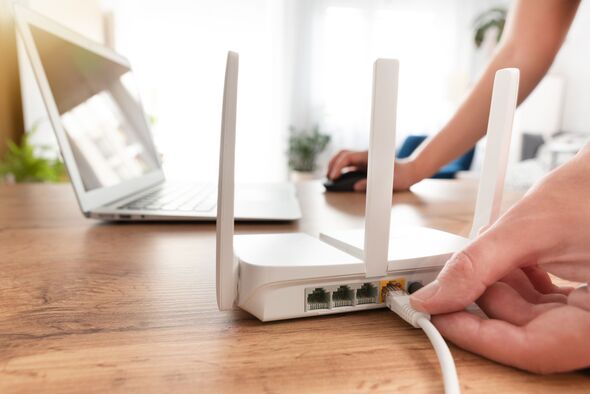The first step to improving your Wi-Fi speed is understanding how wireless networks work. Wi-Fi uses radio waves to transmit data between your router and devices like smartphones, computers, and smart TVs. The speed and reliability of this connection depend on many factors, such as the quality of the router, other interfering devices, walls and other physical obstacles, and even the number of people connected simultaneously. Once you understand these basic principles, it’s easy to identify the cause of slow internet speeds and improve them immediately.
Rebooting Your Router
Rebooting your router is one of the quickest and easiest ways to improve Wi-Fi speed. Over time, a router can become overloaded, causing slowdowns and connection drops. You can reset your router to clear temporary data that can cause slowdowns by turning it off for about 10 seconds and then turning it back on. Power cycling is an easy way to fix common connection issues and improve internet speed without extensive technical knowledge.
Finding the Optimal Placement for your Router
The placement of your Wi-Fi router has a giant impact on network quality. The best place for your router is in a central location in your home, such as on a high shelf, away from walls or other objects that could block the signal. Avoid placing the router in enclosed spaces like corners, basements, or closets. Placing your router in an open space distributes the Wi-Fi signal more evenly throughout your home and reduces interference. A stronger signal means faster speeds and fewer connection drops, especially in areas where there was previously no signal.
Reduce the Impact of Other Devices
Electronic devices like microwaves, cordless phones, baby monitors, and even Bluetooth devices can affect your Wi-Fi signal. These devices use the same frequency and can cause your network to slow down or even stop working altogether. If your router works on both the 2.4 GHz and 5 GHz bands, it’s best to move these devices further away from the 2.4 GHz band and switch to the 5 GHz frequency to reduce interference. The 5 GHz band offers faster speeds and less interference, making it especially useful in homes with many electronic devices. Managing interference effectively results in a clearer signal and faster speeds.
Limit the Number of Connected Devices
The number of devices connected to your network can also affect Wi-Fi speed. Smart homes often have many electronic devices, such as phones, computers, game consoles, and security cameras, all using the same bandwidth. If multiple devices are connected to the internet simultaneously, each device experiences a slower speed. You can free up resources by disconnecting unused devices or prioritizing bandwidth in your router settings. This process ensures that your most important tasks, such as video calls or media streaming, run smoothly without buffering.
Update Router Firmware
Router manufacturers often offer firmware updates to optimize device performance, fix bugs, and improve security. Outdated firmware can cause delays, signal drops, and even compromise system security. You may be able to immediately improve performance by logging into your router’s administrative interface and checking for updates. You can usually download updates from the manufacturer’s website or use the automatic update feature in your router’s settings. Updating the firmware ensures that your router performs optimally and offers the fastest speeds.
Change your Wi-Fi Channel for Better Performance
Wi-Fi networks use multiple channels in the 2.4 GHz and 5 GHz bands. If many networks in your area use the same channel, congestion can occur and slow down your internet speed. You can get a faster and more stable connection by switching to a less congested channel. Most modern routers automatically select the optimal channel, but you can also change it yourself in your router settings. A Wi-Fi analyzer app can help you find the best channel to switch to by quickly scanning the networks around you.
Installing a WiFi Range Extender or Mesh System
If you have a weak or no Wi-Fi connection in certain areas of your home, installing a Wi-Fi extender or upgrading to a mesh Wi-Fi system can significantly improve your connection. A range extender amplifies the signal from your current router and directs it to hard-to-reach areas. A mesh system, on the other hand, uses multiple nodes spread throughout your home to create a seamless network. These solutions eliminate dead spots and ensure consistent coverage, meaning you get faster speeds everywhere in your home. This is especially useful for multi-story buildings, homes with thick walls, or larger spaces.
Conclusion
You don’t have to spend a fortune or have extensive technical knowledge to improve your Wi-Fi speed at home. Simple things like rebooting your router, finding a good location, minimizing the number of devices connected to it, and reducing interference can yield significant results immediately. Updating your router’s firmware, improving network security, and choosing the right Wi-Fi channel can all contribute to better network performance. For homes with certain issues, such as dead spots or heavy use, using a range extender, mesh network, or wired connection can effectively solve the problem. With the right strategy and a little effort, you can enjoy faster, smoother, and more stable internet everywhere in your home.
FAQs
1. Why does my Wi-Fi signal work well in one room but not in another?
Wi-Fi signals weaken over distance, and walls and large furniture can block them. If your router isn’t positioned correctly, you may experience dead spots with a weak or unstable signal.
2. How often should I restart my router?
Most homes only need to restart it weekly or every other week. However, if your internet speed is slow, a quick restart can often solve the problem.
3. Does connecting too many devices slow down your Wi-Fi speed?
Yes, when many devices are connected to the same network, they take up bandwidth and reduce the available speed for each device.
4. How do I know if someone else is using my Wi-Fi?
Log into your router settings to view the devices connected to your network. If you see devices you don’t recognize, it could mean someone else is using your network.
5. Are mesh systems and Wi-Fi extenders the same?
No. An extender amplifies the signal from your current router, which usually means you need to set up a new network. A mesh system uses multiple connected nodes to seamlessly cover your entire home.




